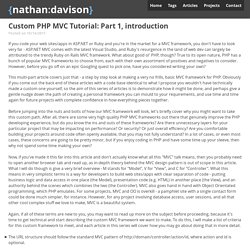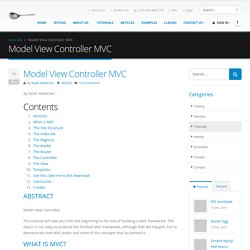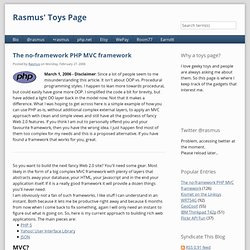

PHP MVC Frameworks. Model View Controller. Model View Controller MVC is a time tested method of separating the user interface of an application from its Domain Logic.

The primary goal of MVC is to isolate UI changes and prevent them from requiring changes to the Domain Logic of the application. The primary reason for this division is that the user interface and Domain Logic have different drivers for change and different rates of change. By making this separation, you can change the UI without touching the Domain Logic and vice versa. MVC is sometimes confused with other patterns that have the same goal of separating user interface from Domain Logic, such as Presentation Abstraction Control. MVC divides an application into three concerns: Model - Encapsulates core application data and functionality Domain Logic. Implementing MVC in PHP: The Controller.
By Joe Stump 11/03/2005. Understanding MVC in PHP. By Joe Stump 09/15/2005 This article series (continued in Implementing MVC in PHP: The Controller, Implementing MVC in PHP: The View, and Implementing MVC in PHP: The Model) demonstrates how to build an MVC web framework using PHP 5. This article covers the basics of MVC web frameworks, building the foundation classes for a framework that the other three articles in this series will build. With the introduction of PHP 5 and its new OOP features developers can now seriously talk about building solid APIs and more complex MVC frameworks for the web in PHP. This was possible before, but the new features in PHP 5 make it easier to integrate more advanced features into MVC frameworks, such as SOAP and WSDL.
In this article I assume that you have a solid understanding of object-oriented programming and that you have at least scanned the upcoming changes to the OOP structure of PHP in PHP5. MVC in PHP part 1: Hello World. 08 Sept 2010 Introduction A basic implementation demonstration of Model-View-Controller (MVC) in PHP. Since writing my article Model-View-Confusion part 1: The View gets its own data from the Model I have received several e-mails asking me to provide a simple example of MVC in PHP.
So I've decided to create one. However, my intent is to build up from a very simplistic example and include some of the reasoning behind certain design decisions and considerations involved in deploying MVC on the web. As stated in my previous article, a lot of other tutorials/articles go off into irrelevant sub-topics. Custom PHP MVC Tutorial: Part 1, introduction. If you code your web sites/apps in ASP.NET or Ruby and you're in the market for a MVC framework, you don't have to look very far - ASP.NET MVC comes with the latest Visual Studio, and Ruby's resurgence in the land of web dev can largely be attributed to the trendy Ruby on Rails MVC framework.

What about good ol' PHP, though? True to its open nature, PHP has a bunch of popular MVC frameworks to choose from, each with their own assortment of positives and negatives to consider. However, before you go off on an epic Googling quest to pick one, have you considered writing your own? This multi-part article covers just that - a step by step look at making a very no frills, basic MVC framework for PHP. Before jumping into the nuts and bolts of how our MVC framework will look, let's briefly cover why you might want to take this custom path. And here is a simplified diagram to summarize how the framework flows: Next up, in part 2, we'll get the URL mapping and index.php sorted. PHP Tutorials Examples phPro - Tutorials Articles Examples Development.
PHP Tutorials Examples Model View Controller MVC. Model View Controller MVC by Kevin Waterson Contents Abstract.

Php - MVC tutorial that doesn't rely on a framework. The no-framework PHP MVC framework. March 1, 2006 - Disclaimer: Since a lot of people seem to me misunderstanding this article.

It isn't about OOP vs. Procedural programming styles. I happen to lean more towards procedural, but could easily have gone more OOP. I simplified the code a bit for brevity, but have added a light OO layer back in the model now. Not that it makes a difference. So you want to build the next fancy Web 2.0 site? I don't have much of a problem with MVC itself. Goals for this approach Clean and simple designHTML should look like HTMLKeep the PHP code in the views extremely simple: function calls, simple loops and variable substitutions should be all you needSecureInput validation using pecl/filter as a data firewallWhen possible, avoid layers and other complexities to make code easier to audit FastAvoid include_once and require_onceUse APC and apc_store/apc_fetch for caching data that rarely changesStay with procedural style unless something is truly an objectAvoid locks at all costs.
Model View Controller. An easy way to understand MVC: the model is the data, the view is the window on the screen, and the controller is the glue between the two. -- ConnellyBarnes The best rubric ever: "We need SMART Models, THIN Controllers, and DUMB Views" The Controller does not oversee the operation of the Views and Models - it's not a GodClass. The controller mediates communication and unifies validation, using either direct calls or the ObserverPattern. Model-View-Controller is the concept introduced by Smalltalk's inventors (TrygveReenskaug and others) of encapsulating some data together with its processing (the model) and isolate it from the manipulation (the controller) and presentation (the view) part that has to be done on a UserInterface.
A model is an object representing data or even activity, e.g. a database table or even some plant-floor production-machine process. Presentation-Abstraction-Control. This architecture is a further development of the Model-View-Controller architecture. The MVC is restricted to simple GUI's with one or more views on the same model. If the model consists of substructures that all require they own special way of interaction, a more complex GUI architecture is in order. The PAC architecture does not have the model as its core component, but a hierarchical structure of PAC components.
Each PAC component consists of these items: Presentation Abstraction Control.